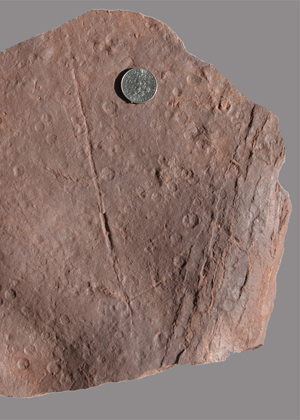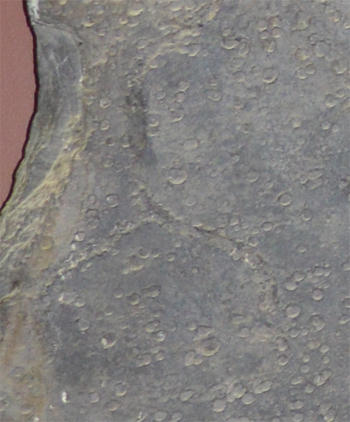Fossil Raindrop Impressions
Global Flood | See All The Videos. Go to the: 30 Second Video Menu

The photo to the right is a close-up of fossil raindrops we have in our museum. The question is, how could this happen? What is required for raindrop impressions to fossilize, and when did those conditions exist?

Raindrop fossils are not rare. You can buy rocks with raindrop impressions on EBay for prices as low as $25 to $30. How could raindrop impressions last long enough to become fossils? And do it frequently? That certainly is not happening today.
Try to imagine a situation in which raindrop impressions in mud would last long enough to become fossilized. No dinosaur walked on them. No animal walked on them. In addition, there are not many of them on this rock. That is normally what we see. It looks like a very brief shower blew through. Or perhaps the impressions were very quickly submerged or buried, preventing additional raindrops from falling on this surface.
In addition, raindrop impressions require mud firm enough to take and hold the impression until it is buried. That means this was either a very brief shower or the continuing rain would have turned the mud to mush. Or the impressions were very quickly, yet gently buried.
Raindrops are short-lived structures. They are not deep and there is not much to them. Even additional rain will quickly obliterate raindrop impressions/ To be preserved they must be buried almost immediately. And they must be buried deeply enough to protect them damage.

Raindrops must also be buried gently. An energetic flow of water, or wave action, will wipe away the impressions.
What about a short rain shower that leaves raindrop impressions, and then the sun comes out? It dries and hardens the mud, preserving the raindrops.
The photo to the right shows a close-up of a large slab in the Berneski Museum with raindrop impressions. You can see a short invertebrate trail that appears to have been left before the rain started. Trails such as this are also short-lived and fragile. Notice that the trail starts and ends. We don't see where the invertebrate came from or went. However, the sediment was soft enough to form raindrop impressions in the invertebrate trail. Did it rise up off the mud and disappear? Hmmm.
Although difficult to see in photographs, another piece of evidence is that on both stones there are are sharp, well-defined raindrop impressions. There are also less distinct impressions that appear to be "under tracks" (using dinosaur footprint terminology). These appear to be impressions that were made, and then buried by a thin layer of sediment.
Rain drop impressions are found on flat bedding plains, with no vegetation. If the impressions dried in the sun and were buried by the next flood, typically an annual flood, there should be evidence of vegetation starting to grow. There is none.
Examining the sediment layers in the fossil in our museum, there are layers distinguished by color, ranging from 1mm to 5mm in thickness. Within those layers are very fine micro layers. There are no signs of erosion, debris collection, or plant growth in the layers.
We also need to note that raindrops do make impressions in mud and sand today. However, we do not see them hardening in the sun nor being preserved as fossils. That points to very unique conditions being required.
The evidence points to a surface that is briefly exposed to rain, then covered with a thin, slowing moving sediment slurry, and then exposed again in a repeating cycle. These are conditions that would exist in temporarily protected areas during the rising water phase of the global flood. The flood waters were unique that they carried a very heavy load of sediment. While extremely violent in some areas, there would be local areas of gentle water movement (increasing and decreasing depths). As water levels rose, at times thin layers of thick slurry would move across the flat sediment plains that had been deposited previously. Friction would cause a rolling action on the front edge, as a new, thin, stationary layer was deposited. The action would be similar to a paint roller leaving a thin layer of paint behind. That thin layer would be briefly exposed to rain (and invertebrates and other organisms) and then then next layer would come rolling through.
The Biblical global flood is the only event in history that could have provided the unique conditions required to preserve raindrop impressions as fossils. In addition, it is the only event that could have left the large, flat bedding plains, with no vegetation, on which raindrop impressions are preserved.
Ancient Raindrops Argue for Young Earth (ICR)
Raindrop Imprints and the Location of the Pre-Flood/Flood boundary (CIM)

Everything is falling apart, nothing makes sense anymore. What's happening?
What is happening is that the world has turned away from God. When nations turn away from God, strangely enough, God turns His back on them. We find out what it is like to live without God.
There is only one thing to do... repent, turn to Jesus Christ in obedience. Jesus said:
If you love Me, you will keep My commandments. - John 14:15
This can only be done on an individual basis. Don't look to others turning to God and making things better for you. YOU must repent, turn away from disobedience. Love God! Obey what He says. Read the Bible to find out what He says.
It happens one person at a time, starting with you. Don't put it off today. Turn to Jesus Christ, God who came to earth in human flesh to save us from the penalty we've earned as a result of our disobedience (sin). He will do it! ...
BUT ONLY when you believe this is true and put your trust in Jesus. Trust Jesus today. Repent (turn away from what the world wants and to what God wants).
Jesus began to preach, “Repent, for the kingdom of heaven has come near.” - Matthew 4:17